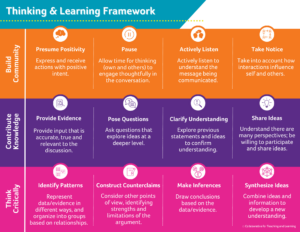For years we have discussed the importance of student engagement in classrooms. Of course we want students engaged in their learning rather than being passive or non-participatory, however, the ways in which we have monitored or evaluated student engagement don’t necessarily guarantee student learning. For example, a student listening to a class discussion can appear engaged while not actually thinking about the material being discussed. Similarly, a student completing a written assignment is engaged because they are doing what was asked, but that does not ensure the task requires any deep thinking.
Engagement – true engagement – certainly is important in classrooms, but I believe we have been missing something by focusing on engagement. Instead, I suggest shifting our nomenclature to emphasize student thinking rather than engagement. By focusing on thinking, we are more likely to ensure students have opportunities to process, make connections, ask questions, draw conclusions, and reflect on their learning. Learning is an iterative process, but the fast pace teachers feel pressured to maintain to “get through” the curriculum does not allow for students to think and learn at a deep level.
It is more important than ever for students to be able to think critically and independently. They need to be able to evaluate information, form their own opinions, and solve problems. However, many students are not being given the opportunity to think for themselves. They are being taught to memorize facts and procedures, rather than to think creatively and critically. Or, when asked a question that might lead to deeper thinking, students are not given sufficient processing time to come up with ideas. “Repeating the answer becomes more important than the process used to get the answer. Consequently, students and teachers frequently deal with learning at the lower levels of complex thinking” (Sousa, 2022).
Allowing and expecting students to think does not happen by accident. Intentional planning is key. Students need models, scaffolds, good questions, processing time, and opportunities for metacognition. They need practice with feedback and tasks that require each student to participate and contribute ideas in a safe way. They need experience going back to their original thinking and adding to it or revising it based on new learning.

CTL’s (2023) Thinking and Learning Framework was designed to promote active thinking and engagement with content through attention to three domains: Build Community, Contribute Knowledge, and Think Critically. Within each domain are four practices that:
- Help students learn to respect the ideas of others while building their own communication and thinking skills;
- Encourage students to use the content they are learning;
- Foster the development of discussion and thinking skills through structured and explicit practices; and
- Enable students to construct arguments and provide evidence.
The framework was designed to improve instruction by providing structure and guidance for teachers so that they can ultimately operationalize rigorous expectations and practices in the classroom. “Rigor is not making assignments longer or harder. It is about students making connections beyond the assignments, reexamining assumptions, and engaging in critical thinking” (Sousa, 2022).
Here are some additional ways of encouraging student thinking that can be supported through use of the Thinking and Learning Framework:
- Create a classroom environment where students feel safe to share their ideas, even if they are different from the teacher’s or other students’ ideas.
- Encourage risk taking and celebrate the learning that comes from making mistakes. “If the school experience is telling our students that they should never be wrong, then they will never take a chance on thinking or proposing any ideas outside the box” (Sousa, 2022)
- Let students operate in gray areas, where there is not one right answer. This allows students to participate without fear of being wrong and to gain confidence in what they can contribute.
- Provide opportunities for students to collaborate and share their ideas with and learn from each other. Brain research shows that talking about new learning aids comprehension and retention (Sousa, 2022), so students need time in class to dialogue with peers.
- Be patient and allow students ample time to process information and formulate their thoughts.
- Celebrate students’ thinking, even if their ideas are not perfect.
With thoughtful planning, a supportive environment, and a commitment to the process, we can help students become more critical thinkers, creative problem-solvers, and – dare I say it – engaged learners.
References:
Collaborative for Teaching and Learning. (2023). Foundations of content literacy. Collaborative for Teaching and Learning.
Sousa, D. A. (2022). How the brain learns. Corwin Press.
